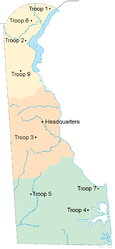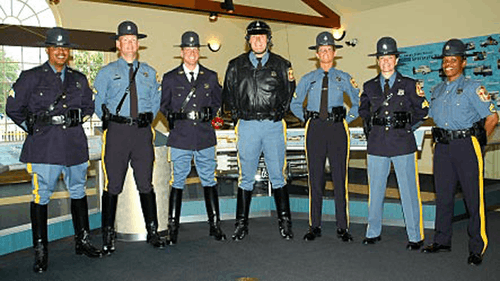Delaware State Police
| Delaware State Police | |
|---|---|
| Abbreviation | DSP |
|
Patch of the Delaware State Police | |
|
Badge of the Delaware State Police | |
| Agency overview | |
| Formed | 1923 |
| Preceding agency | Highway Traffic Police |
| Employees | 847 (as of 2008) [1] |
| Legal personality | Governmental: Government agency |
| Jurisdictional structure | |
| Operations jurisdiction* | State of Delaware, USA |
 | |
| Map of Delaware State Police's jurisdiction. | |
| Size | 1,982 square miles (5,130 km2) |
| Population | 907,135 (2011 est.)[2] |
| General nature | |
| Operational structure | |
| Headquarters | Dover, Delaware |
| Troopers | 658 (as of 2008) [1] |
| Civilians | 205 (as of 2004) [1] |
| Agency executive | Nathaniel McQueen Jr., Colonel |
| Facilities | |
| Troops | 8 |
| Website | |
| http://dsp.delaware.gov/ | |
| Footnotes | |
| * Divisional agency: Division of the country, over which the agency has usual operational jurisdiction. | |
The Delaware State Police (DSP) is a division of the Delaware Department of Public Safety and Homeland Security and is responsible for traffic regulation and law enforcement across the state of Delaware, especially in areas underserved by local police departments. The DSP is headquartered in the capital Dover, Delaware.
Mission statement
"To enhance the quality of life for all Delaware citizens and visitors by providing professional, competent and compassionate law enforcement services".
History
Before the Delaware State Police was formed in 1923, the first traffic law enforcement officers were called the "Highway Traffic Police". Started in 1919, the HTP consisted of one officer whose sole function was to patrol the Philadelphia Pike near Wilmington. In the following year the force was increased to three men and three motorcycles. From 1920 to 1923 these men served directly under the State Highway Commission. Prior to the formation of state police the areas between unincorporated districts were served by the county sheriff department.
Thoughts on the topic of forming a State Police organization for the First State had been recorded as early as 1906. Although interest existed, little, if any, positive steps were taken until the State Highway Commission was formed in 1917. As construction of paved highways was begun and registered motor vehicles began to rise, a need to regulate and maintain safety soon became apparent. On April 23, 1923, the General Assembly, at the request of the State Highway Department, enacted two laws that created the Delaware State Police. This date marks the official organization of the present law enforcement organization.
The Delaware State Police employed 75 full-time officers for every 100,000 residents in 2007, the largest number of any state police force.[3]
Present-day DSP
Troops
Currently, the DSP operates out of eight barracks known as "troops", not including the headquarters. Each county has one troop that is shared between patrol (Uniformed) and detective (CIU) units. Delaware State Police investigate over 33,000 criminal complaints yearly.
- Troop 1 - Penny Hill (near Claymont), New Castle County (uniformed)
- A sub-station of Troop 1 is located on the grounds of the Brandywine Town Center in the Brandywine Hundred section of New Castle County. Now closed.
- Troop 2 - Bear, New Castle County (shared troop)
- Troop 3 - Woodside, Kent County (shared)
- Troop 4 - Georgetown, Sussex County (shared)
- Troop 5 - Bridgeville, Sussex County (uniformed)
- Troop 6 - Prices Corner (near Elsmere), New Castle County (uniformed)
- Troop 7 - Lewes, Sussex County (uniformed)
- Troop 9 - Odessa, New Castle County (uniformed)
Special Units
The DSP also operates several special units/locations around the state, including aviation units in Georgetown and Middletown, and weigh stations on U.S. Rt. 13 and U.S. Rt. 301.
Counties
In Kent and Sussex Counties, the Delaware State Police serve as the primary law-enforcement agency that are not incorporated into municipalities who have their own law enforcement agency.
In New Castle County, the Delaware State Police shares primary jurisdiction with the New Castle County Police. The 1974 jurisdictional agreement between DSP and NCCPD states the New Castle County Police investigates complaints in residences or commercial areas located on county roads or community streets. The Delaware State Police investigates complaints in residences or commercial areas located on state roads or interstate highways. However, in an emergency incident, the closest New Castle County Police officer or Delaware State Police trooper will respond no matter where the complaint originates from.
9-1-1 Dispatch centers
Additionally, the Delaware State Police also provides 9-1-1 dispatch center services in all 3 counties for both DSP and any municipal agencies which do not have their own dispatcher. RECOM is for New Castle County, KENTCOM is for Kent County, and SUSCOM is for Sussex County. The New Castle County Police and several of the larger city police provide their own dispatch services.
Units/Sections
Like other state police agencies, the Delaware State Police has several sub-divisions specializing in addressing particular crimes or security needs.
Full-time Units
- Aviation Unit with four helicopters
- Canine
- Collision Reconstruction Unit
- Command Post Unit
- Commercial Vehicle Enforcement Unit
- Communications
- Community Services
- Crime Lab
- Criminal Investigations Units
- Detective Licensing Section
- Domestic Violence Unit
- High Technology Crimes Unit
- Homeland Security
- Homicide Unit
- Human Resources
- Inspections/Accreditation
- Intelligence Unit
- Internal Affairs
- Motorcycle Unit
- Public Information Office
- Planning Section
- Special Investigations Units
- Street Crimes Units
- State Bureau of Identification
- Training Section
- Traffic Section
- Victim Services
- Video Lottery Enforcement Unit
Part-time Units
- Explosive Ordnance Disposal Unit
- Conflict Management
- SCUBA
- Special Operations Response Team
- Tactical Control Unit
Uniforms

Since the 1950s, members of the DSP have worn uniforms more similar to the State's colors of "blue & gold". In the past, DSP used military type colors of navy & green.
The most distinctive uniform is the "Class A Dress" uniform consisting of a navy blue military dress coat with French blue shoulder epaulets and sleeve cuffs. The long sleeve uniform shirt is French blue in color with a navy blue tie. The DSP patch with bears the great seal of Delaware is worn on the left arm of all uniform items. The trooper's rank is worn on both sleeves. The trooper's years of service "hash-marks" are worn on the lower part of the left arm. The trooper's badge is worn over the left pocket and the nameplate, along with any awards, over the right pocket. A matching French blue color trouser with a 2" gold stripe on the legs is worn with black leather knee-high riding boots. This was the standard everyday uniform in the past. However, it is now worn for special events only.
The standard winter uniform, worn between November and April, is the same as the "Class A Dress" uniform, except that the military dress coat is replaced with a standard patrol jacket. The knee-high boots are replaced with shoes, however some troopers still wear the boots.
The standard summer uniform, worn between April and November, is the same as the winter uniform, except the long sleeve shirt is replaced with a short sleeve shirt and it is worn without the tie. During the summer months the color of the uniform trouser changes from French blue to navy blue with the same 2" gold stripe.
DSP troopers wear a navy blue campaign hat with the state seal. Prior to the 1950s, they wore a tan cavalry style hat like those worn by Maryland troopers.
Troopers holding the rank of Lieutenant and above wear gold badges, namplates, and collar rank. They are also permitted to wear a white color shirt in place of the French blue shirt, but this has fallen out of practice in recent years.
The DSP duty belt is Gould & Goodrich plain black leather with a Safariland "raptor level-3" holster. The ammo pouch, OC spray holder, and handcuff case have silver snaps (gold for Lieutenant and above). The portable radio and ASP baton is also worn on the duty belt. A shoulder strap is used with the "Class A Dress" uniform, otherwise standard belt keepers are used. It is DSP policy that all duty belts are to be worn the same way, so Troopers can not remove or add any equipment to the duty belt.
Best dressed
In 2005, the Delaware State Police were named the "best-dressed state law enforcement agency" according to the National Association of Uniform Manufacturers.
Rank structure
| Title | Insignia | Details |
|---|---|---|
| Colonel | |
Superintendent of the Delaware State Police. |
| Lieutenant Colonel | |
Second in Command of the Delaware State Police. |
| Major | |
Bureau Commander |
| Staff Captain | |
Supervisor of a Section at Headquarters, encompassing several units. |
| Captain | |
Troop Commander, such as Troop 3, located in Kent County. |
| Lieutenant | |
Assistant Troop Commander, oversee the Troop's criminal or traffic activities. |
| Sergeant |  |
Road Supervisor for Troopers, or Supervisor of a specialty unit. |
| Master Corporal |  |
Trooper with 15 years of service. |
| Senior Corporal |  |
Trooper with 12 years of service. |
| Corporal Grade 1 |  |
Trooper with 9 years of service. |
| Corporal |  |
Trooper with 4 years of service. |
| Trooper 1st Class | |
Trooper who has completed the 2 year probationary period. |
| Trooper | |
Entry-level position upon completing the Delaware State Police Academy. |
Fallen officers
Since the establishment of the Highway Traffic Police in 1919, the predecessor to the Delaware State Police, 18 officers have died in the line of duty.[4]
See also
- List of law enforcement agencies in Delaware
- Delaware Capitol Police
- State Police (United States)
- State Patrol
- Highway Patrol
References
- 1 2 3 USDOJ Statistics
- ↑ 2011 Population Estimates
- ↑ Reaves, Brian A. (July 2011). "Census of State and Local Law Enforcement Agencies, 2008" (PDF). U.S. Department of Justice.
- ↑ The Officer Down Memorial Page

